Page 537 of 598
09
9-29
Front windshield wiper service
positions
ONX4090038ONX4090038
This vehicle has a “hidden” wiper design
which means that the wipers cannot
be lifted when they are in their bottom
resting position.
1. Within 20 seconds of turning off the
engine, lift and hold the wiper lever
up to the MIST position for about 2
seconds until the wipers move to the
top wipe position.
2. At this time you can lift the wipers off
the windshield.
3. Gently put the wipers back down onto
the windshield.
4. Turn the wipers to any ON position
to return the wipers to the bottom
resting position.
Type A
OGSR076067OGSR076067
OGSR076066OGSR076066
1. Lift up the wiper blade clip. Then lift
up the wiper blade.
2. While pushing the lock (1), pull down
the wiper blade (2).
OGSR076068OGSR076068
3. Remove the wiper blade from the
wiper arm.
4. Install a new wiper blade assembly in
the reverse order of removal.
5. Return the wiper arm on the
windshield.
Page 539 of 598
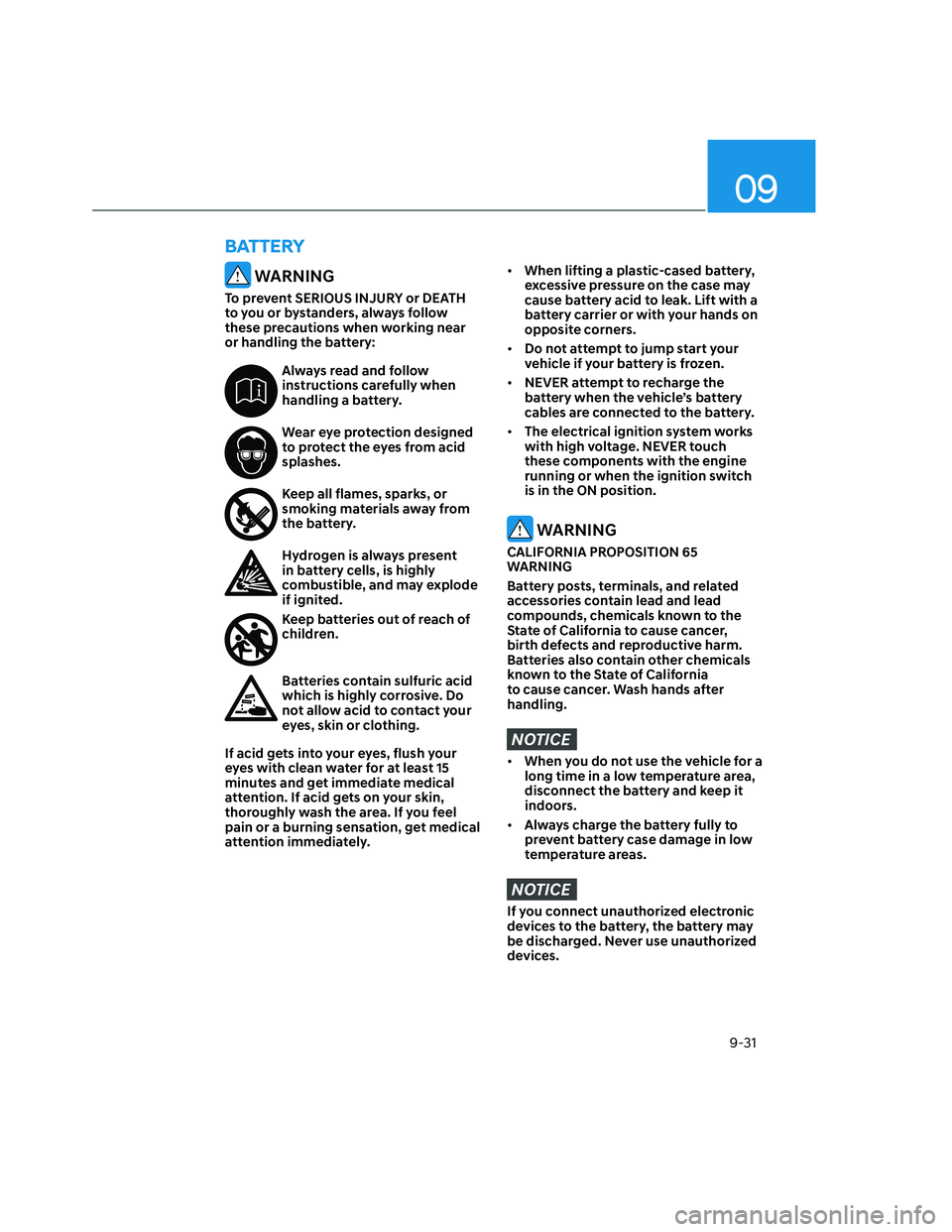
09
9-31
BATTERY
WARNING
To prevent SERIOUS INJURY or DEATH
to you or bystanders, always follow
these precautions when working near
or handling the battery:
Always read and follow
instructions carefully when
handling a battery.
Wear eye protection designed
to protect the eyes from acid
splashes.
Keep all flames, sparks, or
smoking materials away from
the battery.
Hydrogen is always present
in battery cells, is highly
combustible, and may explode
if ignited.
Keep batteries out of reach of
children.
Batteries contain sulfuric acid
which is highly corrosive. Do
not allow acid to contact your
eyes, skin or clothing.
If acid gets into your eyes, flush your
eyes with clean water for at least 15
minutes and get immediate medical
attention. If acid gets on your skin,
thoroughly wash the area. If you feel
pain or a burning sensation, get medical
attention immediately.
• When lifting a plastic-cased battery,
excessive pressure on the case may
cause battery acid to leak. Lift with a
battery carrier or with your hands on
opposite corners.
• Do not attempt to jump start your
vehicle if your battery is frozen.
• NEVER attempt to recharge the
battery when the vehicle’s battery
cables are connected to the battery.
• The electrical ignition system works
with high voltage. NEVER touch
these components with the engine
running or when the ignition switch
is in the ON position.
WARNING
CALIFORNIA PROPOSITION 65
WARNING
Battery posts, terminals, and related
accessories contain lead and lead
compounds, chemicals known to the
State of California to cause cancer,
birth defects and reproductive harm.
Batteries also contain other chemicals
known to the State of California
to cause cancer. Wash hands after
handling.
NOTICE
• When you do not use the vehicle for a
long time in a low temperature area,
disconnect the battery and keep it
indoors.
• Always charge the battery fully to
prevent battery case damage in low
temperature areas.
NOTICE
If you connect unauthorized electronic
devices to the battery, the battery may
be discharged. Never use unauthorized
devices.
Page 541 of 598
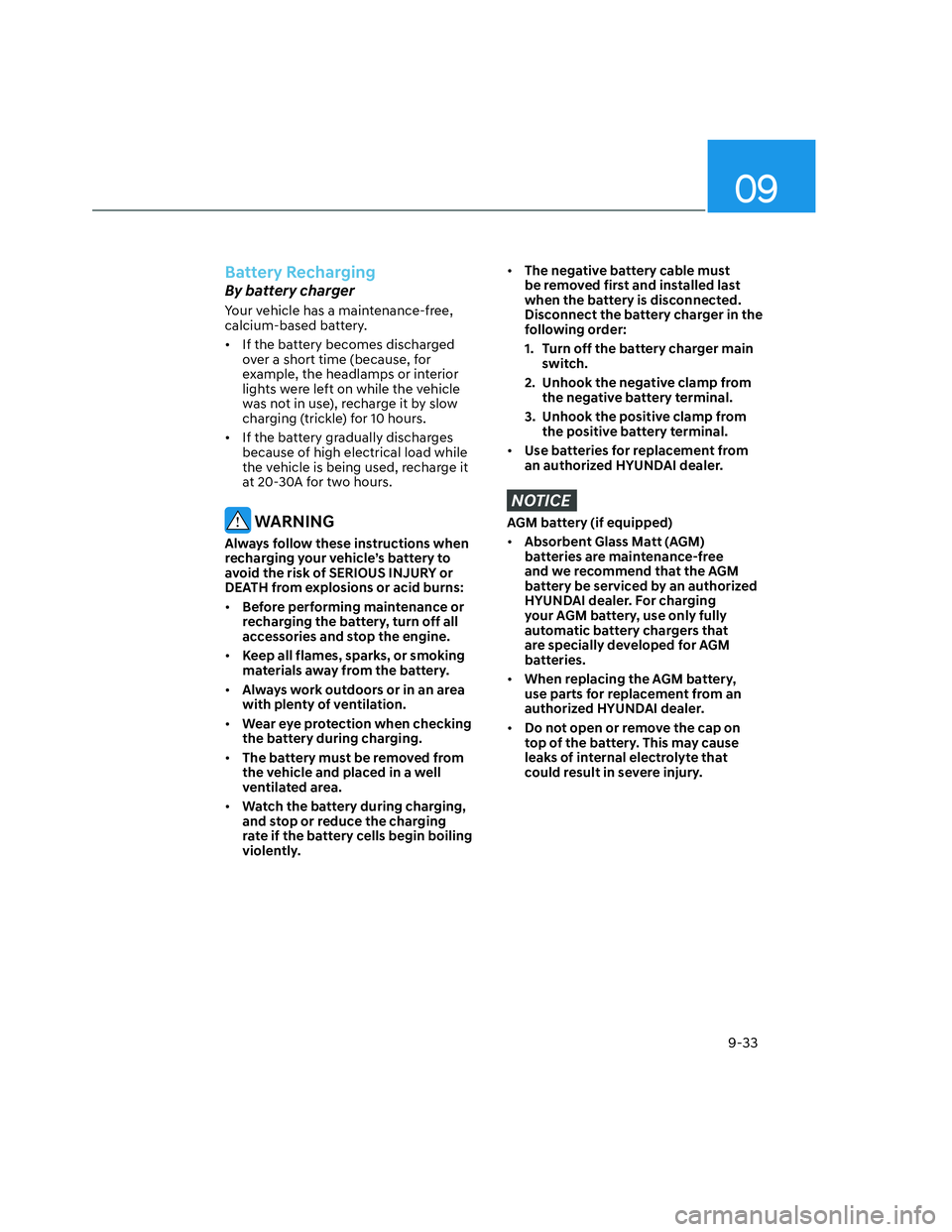
09
9-33
Battery Recharging
By battery charger
Your vehicle has a maintenance-free,
calcium-based battery.
• If the battery becomes discharged
over a short time (because, for
example, the headlamps or interior
lights were left on while the vehicle
was not in use), recharge it by slow
charging (trickle) for 10 hours.
• If the battery gradually discharges
because of high electrical load while
the vehicle is being used, recharge it
at 20-30A for two hours.
WARNING
Always follow these instructions when
recharging your vehicle’s battery to
avoid the risk of SERIOUS INJURY or
DEATH from explosions or acid burns:
• Before performing maintenance or
recharging the battery, turn off all
accessories and stop the engine.
• Keep all flames, sparks, or smoking
materials away from the battery.
• Always work outdoors or in an area
with plenty of ventilation.
• Wear eye protection when checking
the battery during charging.
• The battery must be removed from
the vehicle and placed in a well
ventilated area.
• Watch the battery during charging,
and stop or reduce the charging
rate if the battery cells begin boiling
violently.
• The negative battery cable must
be removed first and installed last
when the battery is disconnected.
Disconnect the battery charger in the
following order:
1. Turn off the battery charger main
switch.
2. Unhook the negative clamp from
the negative battery terminal.
3. Unhook the positive clamp from
the positive battery terminal.
• Use batteries for replacement from
an authorized HYUNDAI dealer.
NOTICE
AGM battery (if equipped)
• Absorbent Glass Matt (AGM)
batteries are maintenance-free
and we recommend that the AGM
battery be serviced by an authorized
HYUNDAI dealer. For charging
your AGM battery, use only fully
automatic battery chargers that
are specially developed for AGM
batteries.
• When replacing the AGM battery,
use parts for replacement from an
authorized HYUNDAI dealer.
• Do not open or remove the cap on
top of the battery. This may cause
leaks of internal electrolyte that
could result in severe injury.
Page 556 of 598
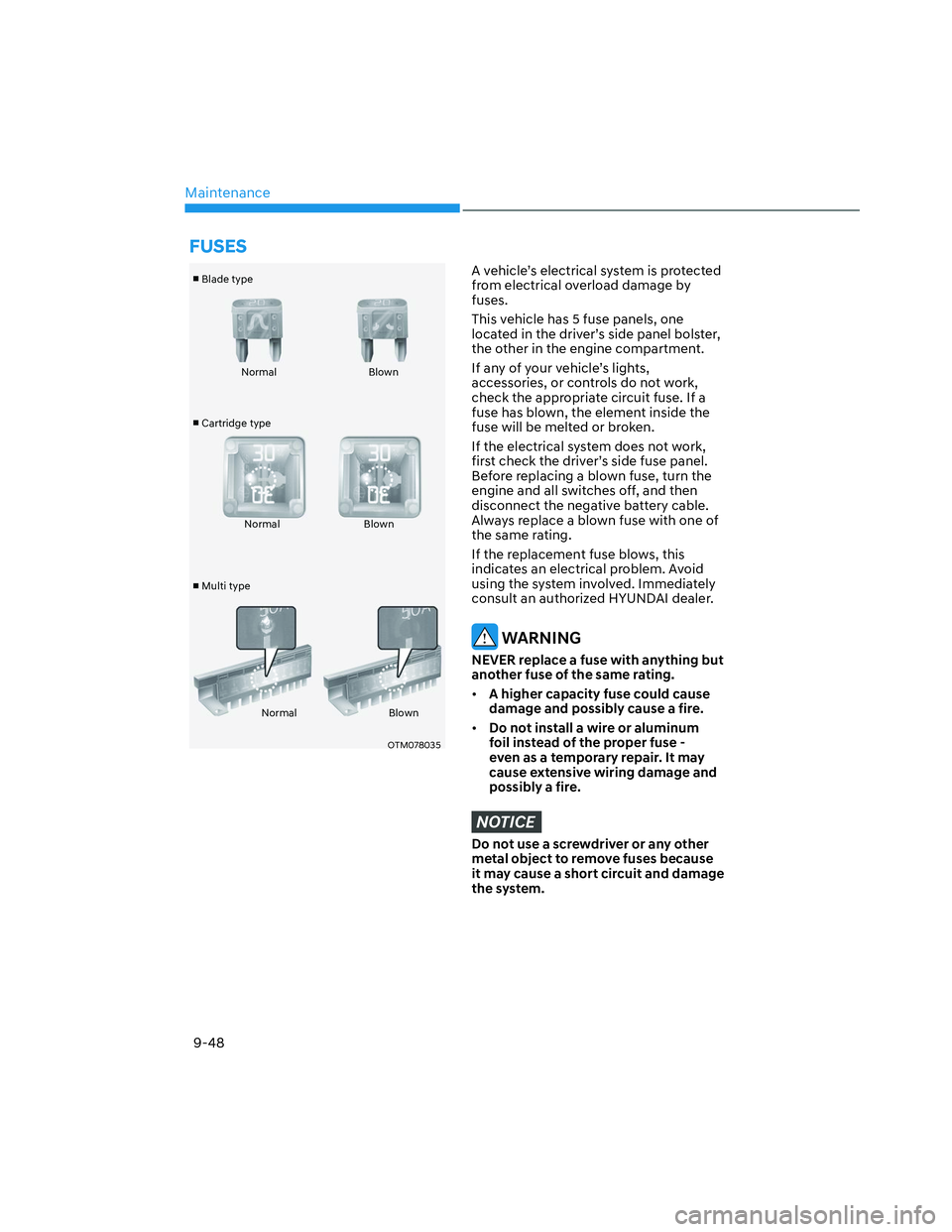
Maintenance
9-48
�v
Blade type
�v
Cartridge type
�v
Multi typeNormal Blown
Normal Blown
Normal Blown
OTM078035OTM078035
A vehicle’s electrical system is protected
from electrical overload damage by
fuses.
This vehicle has 5 fuse panels, one
located in the driver’s side panel bolster,
the other in the engine compartment.
If any of your vehicle’s lights,
accessories, or controls do not work,
check the appropriate circuit fuse. If a
fuse has blown, the element inside the
fuse will be melted or broken.
If the electrical system does not work,
first check the driver’s side fuse panel.
Before replacing a blown fuse, turn the
engine and all switches off, and then
disconnect the negative battery cable.
Always replace a blown fuse with one of
the same rating.
If the replacement fuse blows, this
indicates an electrical problem. Avoid
using the system involved. Immediately
consult an authorized HYUNDAI dealer.
WARNING
NEVER replace a fuse with anything but
another fuse of the same rating.
• A higher capacity fuse could cause
damage and possibly cause a fire.
• Do not install a wire or aluminum
foil instead of the proper fuse -
even as a temporary repair. It may
cause extensive wiring damage and
possibly a fire.
NOTICE
Do not use a screwdriver or any other
metal object to remove fuses because
it may cause a short circuit and damage
the system.
FUSES
Page 557 of 598
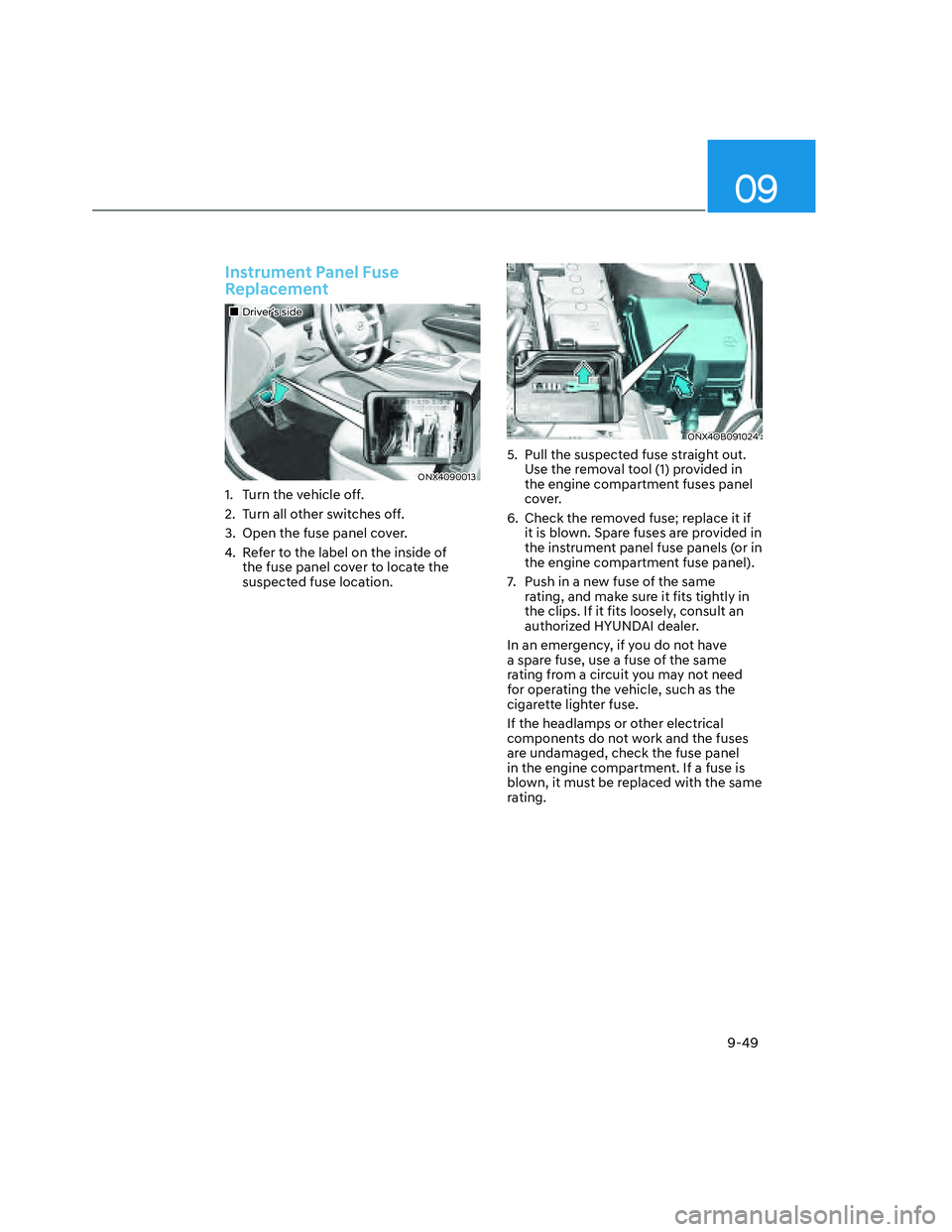
09
9-49
Instrument Panel Fuse
Replacement
�����„�„Driver’s sideDriver’s side
ONX4090013ONX4090013
1. Turn the vehicle off.
2. Turn all other switches off.
3. Open the fuse panel cover.
4. Refer to the label on the inside of
the fuse panel cover to locate the
suspected fuse location.
ONX4OB091024ONX4OB091024
5. Pull the suspected fuse straight out.
Use the removal tool (1) provided in
the engine compartment fuses panel
cover.
6. Check the removed fuse; replace it if
it is blown. Spare fuses are provided in
the instrument panel fuse panels (or in
the engine compartment fuse panel).
7. Push in a new fuse of the same
rating, and make sure it fits tightly in
the clips. If it fits loosely, consult an
authorized HYUNDAI dealer.
In an emergency, if you do not have
a spare fuse, use a fuse of the same
rating from a circuit you may not need
for operating the vehicle, such as the
cigarette lighter fuse.
If the headlamps or other electrical
components do not work and the fuses
are undamaged, check the fuse panel
in the engine compartment. If a fuse is
blown, it must be replaced with the same
rating.
Page 558 of 598
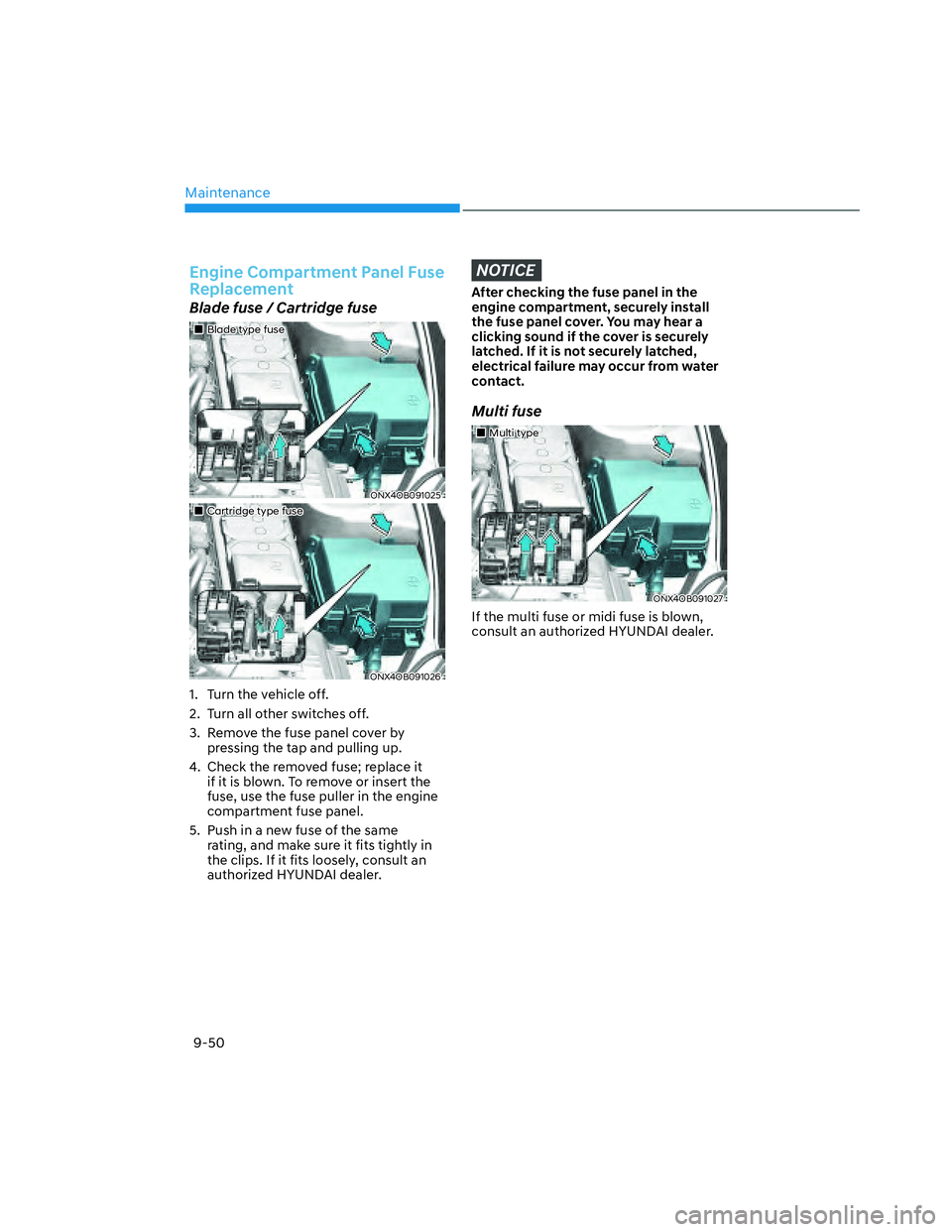
Maintenance
9-50
Engine Compartment Panel Fuse
Replacement
Blade fuse / Cartridge fuse
�����„�„Blade type fuseBlade type fuse
ONX4OB091025ONX4OB091025
�����„�„Cartridge type fuseCartridge type fuse
ONX4OB091026ONX4OB091026
1. Turn the vehicle off.
2. Turn all other switches off.
3. Remove the fuse panel cover by
pressing the tap and pulling up.
4. Check the removed fuse; replace it
if it is blown. To remove or insert the
fuse, use the fuse puller in the engine
compartment fuse panel.
5. Push in a new fuse of the same
rating, and make sure it fits tightly in
the clips. If it fits loosely, consult an
authorized HYUNDAI dealer.
NOTICE
After checking the fuse panel in the
engine compartment, securely install
the fuse panel cover. You may hear a
clicking sound if the cover is securely
latched. If it is not securely latched,
electrical failure may occur from water
contact.
Multi fuse
�����„�„Multi typeMulti type
ONX4OB091027ONX4OB091027
If the multi fuse or midi fuse is blown,
consult an authorized HYUNDAI dealer.
Page 562 of 598
Maintenance
9-54
Engine compartment fuse panel
(Engine room junction block)
ONX4OB091028ONX4OB091028
Inside the fuse/relay box cover, you can
find the fuse/relay label describing fuse/
relay names and ratings.
Information
Not all fuse panel descriptions in this
manual may be applicable to your vehicle;
the information is accurate at the time of
printing. When you inspect the fuse panel
in your vehicle, refer to the fuse panel
label.
ONX4OB091004
Page 563 of 598
![HYUNDAI SANTA CRUZ 2023 Owners Manual 09
9-55
Engine compartment fuse panel
Type Fuse NameFuse
RatingCircuit Protected
MULTI
FUSEMDPS80A MDPS Unit
COOLING FAN180A [G4KP] Cooling Fan Controller
COOLING FAN260A [G4KN] Cooling Fan Controlle HYUNDAI SANTA CRUZ 2023 Owners Manual 09
9-55
Engine compartment fuse panel
Type Fuse NameFuse
RatingCircuit Protected
MULTI
FUSEMDPS80A MDPS Unit
COOLING FAN180A [G4KP] Cooling Fan Controller
COOLING FAN260A [G4KN] Cooling Fan Controlle](/manual-img/35/56179/w960_56179-562.png)
09
9-55
Engine compartment fuse panel
Type Fuse NameFuse
RatingCircuit Protected
MULTI
FUSEMDPS80A MDPS Unit
COOLING FAN180A [G4KP] Cooling Fan Controller
COOLING FAN260A [G4KN] Cooling Fan Controller
B+260A ICU Junction Block (IPS7, IPS8, IPS9, IPS10, IPS11, IPS12)
B+360AICU Junction Block (Fuse - P/SEAT DRV, SAFETY P/
WINDOW RH, S/HEATER DRV/PASS, SUNROOF1, BED
STORAGE, Power Window Main Relay)
E-CVVT150A E/R Junction Block (E-CVVT Relay)
BLOWER40A E/R Junction Block (Blower Relay)
EPB140A ESC Module
REAR HEATED40A E/R Junction Block (Rear Heated Relay)
TRAILER 130A [G4KP] Trailer Connector
B+440AICU Junction Block (Fuse - DOOR LOCK, SAFETY P/
WINDOW LH, TAILGATE OPEN, AMP, IBU2, AIR BAG2,
CARGO LP, BRAKE SWITCH, MODULE9, Long Term
Load Latch Relay)
EPB260A ESC Module
FUEL PUMP20A E/R Junction Block (Fuel Pump Relay)
4WD20A AWD ECM
TRAILER 230A
[G4KN] Trailer Controller
AMS10A Battery Sensor
TRAILER 330A
[G4KN] Trailer Connector
ECU215A PCM/ECM
VACUUM PUMP120A
[G4KP] E/R Junction Block (Vacuum Pump Relay)
TCU115A [G4KN] PCM
ROOF LIGHT FRT15A Accessory Light Switch
E-CVVT220A [G4KP] ECM
HEATED MIRROR10AE/R Junction Block (Rear Heated Relay), Driver/
Passenger Power Outside Mirror
VACUUM PUMP210A [G4KP] ESC Module
TCU360A [G4KP] TCM
EOP60A [G4KP] Electronic Oil Pump
B+150A ICU Junction Block (IPS1, IPS3, IPS4, IPS5, IPS6,)
PTC HEATER50A E/R Junction Block (PTC Heater Relay)
INVERTER30A AC Inverter Module